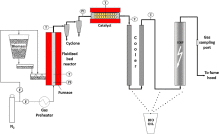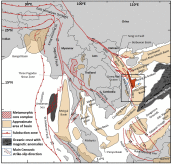BÀI BÁO KHOA HỌC


T.S.Nguyen, T.L.Duong, T.T.T.Pham
D.T.Nguyen, P.N.Le, H.L.Nguyen, T.M.Huynh
Vietnam Petroleum Institute
Online catalytic deoxygenation of vapour from fast pyrolysis of Vietnamese sugarcane bagasse over sodium-based catalysts
Online upgrading of the obtained vapour from fast pyrolysis of sugarcane bagasse over sodium-based catalysts was studied in a fixed-bed reactor at 500 °C. Over Na2CO3/γ-Al2O3 catalyst, both its physico-chemical properties and concentration of sodium salt play significant roles in its performance. Larger pore size is advantageous since it was shown to facilitate the conversion of lignin-derived high molecular weight molecules, leading to a better deoxygenation activity. Surface area and pore volume were also shown to play a certain role in the overall catalytic performance. 25 wt.% of Na2CO3 was shown to be the optimum concentration in terms of deoxygenation activity which might correspond to the highest number of sodium active sites. The sodium concentration was shown to play a bigger role than the surface area and porosity in the catalytic performance of Na2CO3/γ-Al2O3 materials. On the other hand, HZSM-5, as a reference catalyst, was shown to possess deoxygenation activity that is comparable to that of Na2CO3/γ-Al2O3 catalyst. Conversion of oxygenates present in vapour into aromatic hydrocarbons was favoured in the presence of HZSM-5 catalyst while the catalytic scission of alkoxy groups in lignin-derived compounds was facilitated with Na2CO3/γ-Al2O3.
Correlation between the porosity of γ-Al2O3 and the performance of CuO–ZnO–Al2O3 catalysts for CO2 hydrogenation into methanol
Lê Phúc Nguyên, Trần Văn Trí, Ngô Thùy Phương
Nguyễn Hữu Lương, Trịnh Thanh Thuật
Vietnam Petroleum Institute
Norwegian University of Science and Technology
The influence of the porosity of γ-Al2O3 on the performance of CuO–ZnO–Al2O3 catalysts for methanol synthesis from H2 + CO2 mixture was studied. Various types of γ-Al2O3 with different surface areas (from 130 to 280 m2/g) and pore sizes (from 3 to 11 nm) were investigated. N2 adsorption, XRD, TPR studies and grand canonical Monte Carlo simulation were utilized to determine the correlation between their physico-chemical properties and catalytic performance. It was shown that the crystallite size of CuO (determined by XRD) and BET surface area of supports are not the key factors for methanol productivity. The TPR profiles of catalysts demonstrated a direct relationship between CuO–ZnO interaction with their catalytic performance. Interestingly, samples with the uniform pore size of 5 nm exhibit a higher CuO–ZnO interaction and the highest methanol yield. In addition, at this pore size, simulation results showed that the ratio of H2 and CO2 inside the γ-Al2O3 pore was 1.5, which could be an appropriate feed ratio for high methanol productivity.

Vũ Thế Anh, Michael Bryld Wessel Fyhn, Trịnh Xuân Cường
Nguyễn Thanh Tùng, Hoàng Ngọc Đang, Phạm Thanh Liêm, Ngô Văn Hùng
Vietnam Petroleum Institute
Geological Survey of Denmark and Greenland
Petrovietnam Exploration and Production Corporation Petrovietnam
Cenozoic tectonic and stratigraphic development of the Central Vietnamese continental margin
The East Vietnam Boundary Fault Zone (EVBFZ) forms the seaward extension of the Red River Shear Zone and interacted with the extensional rift systems in basins along the Central Vietnamese continental margin. The structural outline of the central Vietnamese margin and the timing of deformation are therefore fundamental to understanding the development of the South China Sea and its relation to Indochinese escape tectonism and the India-Eurasia collision. This study investigates the structural and stratigraphic evolution of the Central Vietnamese margin in a regional tectonic perspective based on new 2-D seismic and well data. The basin fill is divided into five major Oligocene to Recent sequences separated by unconformities. Deposition and the formation of unconformities were closely linked with transtension, rifting, the opening of the South China Sea and Late Neogene uplift and denudation of the eastern flank of Indochina. The structural outline of the Central Vietnamese margin favors a hybrid tectonic model involving both escape and slab-pull tectonics. Paleogene left-lateral transtension over the NNW-striking EVBFZ, occurred within the Song Hong Basin and the Quang Ngai Graben and over the Da Nang Shelf/western Phu Khanh Basin, related to the escape of Indochina. East of the EVBFZ, Paleogene NE-striking rifting prevailed in the outer Phu Khanh Basin and the Hoang Sa Graben fitting best with a prevailing stress derived from a coeval slab-pull from a subducting proto-South China Sea beneath the southwest Borneo – Palawan region. Major rifting terminated near the end of the Oligocene. However, late stage rifting lasted to the Early Miocene when continental break-up and seafloor spreading commenced along the edge of the outer Phu Khanh Basin. The resulting transgression promoted Lower and Middle Miocene carbonate platform growth on the Da Nang Shelf and the Tri Ton High whereas deeper marine conditions prevailed in the central part of the basins. Partial drowning and platform retreat occurred after the Middle Miocene due to increased siliciclastic input from the Vietnamese mainland. As a result, siliciclastic, marine deposition prevailed offshore Central Vietnam during the Pliocene and Pleistocene.
Đoàn Huy Hiên, Seonghuyng Jang, Tạ Quang Minh
Bùi Việt Dũng, Nguyễn Thanh Tùng
Vietnam Petroleum Institute
Korea Institute of Geosciences and Mineral Resources
Sensitivity evaluation of a seismic interpolation algorithm
Sparse seismic acquisition is a new trend in seismic exploration, as it costs much less than conventional methods. To maintain the initial resolution of the seismic image, we propose several ways to sample data irregularly but periodically. These were tested by decimating the synthetic data, then interpolating, imaging and inversion. At every processing step, we quantified the effect of interpolation by comparing the results with those from the fully sampled data. Once the numerical test suggested the best decimation scheme, we were able to proceed to test the real dataset. This test confirmed that sparse acquisition using 60% of the available data is feasible.
